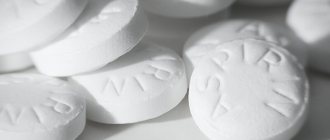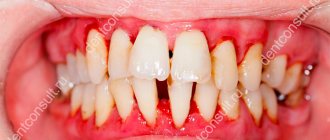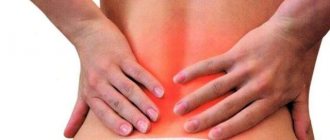Ibuklin is a well-known drug on the Russian market for eliminating the symptoms of ARVI, fever and pain of various origins. Its components ibuprofen and paracetamol are more active together than separately. This is the distinctive feature of the drug Ibuklin - it is chosen by patients who are not very well helped by drugs with one component.
Ibuklin 20 tablets
Instructions for use of Ibuklin tablets
A few words about pharmacology and dosage combinations. Ibuklin - tablet composition: ibuprofen 400 mg, paracetamol 325 mg. Anti-inflammatory, antipyretic and analgesic effects are the basis of the drug’s activity.
In the body, Ibuklin reduces the activity of various types of prostaglandins involved in the inflammatory response - ibuprofen is responsible for this. Paracetamol, in turn, reduces elevated temperature, acting through the thermoregulation center. Both remedies relieve pain, and the spectrum is so wide that it even helps eliminate pain after surgery.
What is Ibuklin
The drug contains two active ingredients: ibuprofen and paracetamol. These are effective non-steroidal compounds with analgesic properties. Together they have a more complete therapeutic effect:
- Ibuprofen, with its moderate analgesic properties, more significantly reduces the intensity of inflammation;
- Paracetamol is a good analgesic and relieves painful symptoms for a long time.
Both substances affect thermoregulation centers and normalize body temperature during fever and acute infectious processes.
Ibuklin is produced:
- for adults: in the form of oblong capsules with a film shell: orange. In 1 piece contains 400 mg of ibuprofen and 325 mg of paracetamol;
- for children: Ibuprofen Junior with a measuring spoon in the package: non-coated soluble tablets, pink, with small inclusions, have a mint smell, ibuprofen content - 100 mg, paracetamol - 125 mg.
Additional components of the drug include: talc, silicon, starch, magnesium stearate.
Use of the drug Ibuklin
The combination of two analgesics and antipyretics puts an increased burden in the form of side effects on the kidneys, liver, blood vessels, heart and other systems of the immature body of a small patient. In this regard, only a doctor prescribes Ibuklin for children with fever.
Here are some mistakes that patients make. The drug removes inflammation so effectively that people think that Ibuklin is an antibiotic, and there is no point in seeing a doctor. However, Ibuklin does not affect bacteria. Temporary disappearance of symptoms does not always mean complete recovery. It is important to check the blood and lungs in order to exclude the erased form of pneumonia and other diseases. The therapist will tell you how to better and faster assess your health status, especially since the risk of pneumonia increases during a pandemic.
Description of the drug
Today Ibuklin is used for various pains: dental, headache, muscle, menstrual. The drug is effective for the following problems:
- colds, accompanied by body aches and migraines;
- exacerbation of chronic pathologies of tissues and joints;
- in the first days after injury;
- toothache;
- period;
- inflammation of the reproductive organs.
The indications are identical for adults and children (the only difference is the dosage).
What should you pay attention to when treating with Ibuklin?
- Ibuklin does not combine with all antibiotics. You should tell the doctor about all the medications the patient is using or avoid harmful interactions yourself. Antibiotics from the cephalosporin group are at risk.
- The common drug Aspirin (acetylsalicylic acid) loses its effectiveness while taking the drug Ibuklin. This is especially noticeable when the patient takes aspirin as an antiplatelet drug for the heart.
- Important! Concomitant use with alcoholic beverages is contraindicated, as erosion may begin in the stomach or intestines.
- The effectiveness of anticoagulants is significantly increased when taken together.
- Insulin and other drugs that lower blood sugar also increase their effect.
- The effect of antihypertensive drugs and diuretics is reduced
- Other negative combinations: myelotoxic drugs, antacids, valproic acid, cefamandole, cefoperazone, drugs with gold, caffeine, plicamycin, cefotitan, digoxin. Increases the blood concentration of digoxin, lithium and methotrexate.
- Important! The patient should ensure that Ibuklin is not accidentally combined with other anti-inflammatory drugs.
- Two days before blood tests, you should stop taking Ibuklin (this applies to diagnosing the level of sugar, uric acid and steroid derivatives).
- It is undesirable to drive vehicles and mechanisms where increased attentiveness and reaction speed are required.
Ibuklin, 400 mg+325 mg, film-coated tablets, 10 pcs.
Dr. Reddy_s Laboratories, India
Price from 123₽
Ibuklin, 400 mg+325 mg, film-coated tablets, 20 pcs.
Dr. Reddy_s Laboratories, India
Not available
There are contraindications. Specialist consultation is required.
Contraindications
You should stop using the drug:
- in case of an allergic reaction to its components;
- with internal bleeding;
- for ulcerative processes of the stomach and intestines;
- severe renal, liver failure;
- inflammation of the optic nerve;
- bronchial asthma;
- polypous growths in the sinuses
- pathologies of the hematopoietic system;
- pregnant women in the last trimester.
The toxicity of Ibuklin increases when taken simultaneously with aspirin, anticoagulants, cyclosporine and gold.
How does Ibuklin affect the kidneys and liver?
In case of any problems with these organs, you need to be especially careful. If renal clearance is less than 30 ml/min, it is prohibited to use Ibuklin. Liver diseases in the active phase and proven failure of this organ are a contraindication.
- The drug for adults should not be confused with other types; Ibuklin for children, available in pharmacies with a prescription, was created for younger patients.
- Elderly patients should use the medicine with caution because their kidney and liver functions are not as active as in young people.
How to take Ibuklin
The pills are swallowed with water half an hour before meals or 2 hours after. There is no need to chew or grind them. General dosage recommendation:
- 1 capsule three times a day;
- the interval between doses is at least 4 hours;
- You are allowed to take up to 6 capsules per day;
- For people with liver disease, it is important to take a break of 8 hours, taking no more than 3 doses of the drug per day.
The maximum duration of treatment is up to 5 days. If symptoms do not subside, you should consult your doctor to prescribe another drug.
Side effects
As often happens, with stronger drugs the group of adverse reactions increases. May be observed:
- In the gastrointestinal tract there is atony, pain, nausea, vomiting, erosion, diarrhea. Disorders of the liver, pancreas, inflammation in the oral cavity.
- Worsened mood, decreased hearing or vision, headache, drowsiness or agitation.
- Increased blood pressure and heart rate. Manifestations of heart failure are possible.
- Impaired hematopoietic function.
- Bronchial spasm, shortness of breath.
- Edema, cystitis, kidney dysfunction.
- Allergies, redness on the skin with itching, bronchial spasm, allergic rhinitis, anaphylactic shock, hyperthermia.
- Distorted blood parameters are possible, for example, when testing for sugar or hemoglobin.
- Increased sweating.
- If the patient took Ibuklin for longer than the time specified in the instructions, then the side effects are noticeable. This can be various types of bleeding.
Side effects
Among the possible negative reactions of the body while taking Ibuklin:
- epigastric pain, nausea, dry mouth;
- dizziness, development of anxiety;
- blood pressure surges, tachycardia;
- changes in laboratory blood parameters;
- swelling;
- increased sweating.
If severe symptoms develop, the possibility of individual intolerance to the drug should be excluded and the dosage should be reconsidered.
For what diseases and conditions is the use of the drug prohibited?
- Third trimester of pregnancy, and in the first and second only by doctor’s decision;
- hypersensitivity to the components of the drug Ibuklin;
- Gastrointestinal tract - any inflammatory processes;
- Gastrointestinal tract - any bleeding;
- peptic ulcer of the stomach and duodenum;
- dysfunction of the liver and kidneys, failure of the function of these organs;
- aspirin intolerance;
- high concentration of potassium in the blood;
- blood dysfunction;
- bronchial asthma and hay fever;
- allergies or intolerance to other anti-inflammatory drugs;
- children under 12 years of age;
- disruption of the optic nerve;
- absence of the cytosolic enzyme glucose-6-phosphate dehydrogenase;
- operations on the arteries of the heart.
A doctor's advice will be required if a person has the following diseases or is taking these medications:
- Cirrhosis of the liver;
- increased bilirubin concentration;
- hepatitis of viral etiology;
- taking corticosteroids;
- vascular diseases of the brain;
- dysfunction of lipid metabolism;
- diabetes;
- circulatory disorders in the arteries;
- smoking, alcoholism;
- taking medications that affect blood clotting and serotonin metabolism.
Ibuklin for colds and flu
What problems does it help with?
Tablets are prescribed for pathological conditions in which inflammatory processes, pain, and increased body temperature occur. These conditions include:
- fever accompanied by fever and infections (including colds);
- muscle pain;
- pain in the area of peripheral nerves as a result of non-infectious lesions;
- back pain caused by problems with the spine;
- tooth pain;
- joint pain due to the appearance of inflammatory reactions;
- painful menstruation.
Ibuklin is prescribed for symptomatic treatment, for inflammatory processes and elevated body temperature as part of general therapy. It does not affect the course of the disease and does not slow down its development.
Ibuklin - analogues without a prescription
We will find exactly the same composition of active ingredients in the drug Nurofen Intensive, but only it has different doses: ibuprofen 200 mg, paracetamol - 500 mg. The manufacturer focuses on pain of moderate severity, including the period after operations, injuries, sore throat, lumbago, osteoarthritis, toothache and headache. If the patient complains about the kidneys, then it is better for him to opt for the drug Ibuklin, since it contains a lower dose of paracetamol.
One of the famous Russian ones should be called Next. Here the company decided to move away from large doses of paracetamol, it is only 200 mg, and ibuprofen 400 mg. It is quite possible to replace Ibuklin, the indications are the same. And in the Next Uno Express drug, the manufacturer has completely removed paracetamol; it only contains ibuprofen in a small dose of 200 mg, while the form is safe - a capsule. For those who are not in very good health, Next Uno Express is well suited; you can get by with a smaller dose of ibuprofen, i.e. drink no more than 200 mg in a single dose. For those who do not like to take pills, there is an external form - Next Active Gel for pain in muscles, back, joints and injuries.
We also find a complete coincidence of active substances in the Indian medicine Brustan. You can freely make a replacement.
The Sintez Russia company presents Paracitolgin (paracetamol 325 mg and ibuprofen 400 mg), however, they do not have a children's version. Medisorb has Nurolgon tablets.
There are a lot of single-component replacement drugs; you can choose any other Nurofen, Ibuprofen from Russian companies with the same trade name, as well as Ibufen or Mig. There are also many paracetamols in pure form from Russian companies. Foreign ones are: Efferalgan, Panadol - the most famous.
If we are talking only about a cold or acute respiratory viral infection, it makes sense to consider complex remedies with paracetamol. These are high-quality well-known drugs, such as: Fervex, Coldrex, Maxicold, Antigrippin. They have a peculiarity - there is a lot of paracetamol (500 mg or more). Therefore, if you have sensitive liver and kidneys, it is better to avoid them. Theraflu stands out separately, with paracetamol 325 mg, i.e. it works smoother.
When you need to bring down the temperature, and the pain syndrome is not very pronounced, a drug similar in action to Aspirin (acetylsalicylic acid) is suitable. The difference is that this drug has more pronounced side effects in the gastrointestinal tract, and there is also an increased risk of various bleedings. For this reason, cold powders are mainly produced with paracetamol.
Nurofen Intensive, 200 mg+500 mg, film-coated tablets, 6 pcs.
Reckitt Benckiser, UK
Price from 118₽
Next, 400 mg+200 mg, film-coated tablets, pain reliever, 20 pcs.
OTC Pharm, Russia
Price from 228₽
Fervex, 500 mg+25 mg+200 mg, powder for oral solution, lemon with sugar, 13.1 g, 8 pcs.
UPSA, France
Price from 175₽
There are contraindications. Specialist consultation is required.
Mechanism of action of Ibuklin
The active substances of NSAIDs inhibit the production of prostaglandins - pain mediators, and at the same time facilitate the proliferative and esudative period of inflammation. Ibuklin eliminates pain syndromes of various origins, reducing the severity of accompanying symptoms:
- reduces stiffness of limbs due to arthritis;
- eliminates malaise and fever during ARVI.
The drug is completely absorbed from the stomach into the bloodstream, the concentration reaches a maximum within 2 hours. Penetrates into biological fluids, including articular synovium. The effect of Ibuklin begins 15–20 minutes after administration and lasts up to 5–6 hours.
The drug has no effect on the duration and intensity of the disease, having only a symptomatic effect.
Advantages of the drug Ibuklin
Very often, doctors notice that medications for ARVI symptoms with one component (paracetamol or ibuprofen) do not work effectively enough. In these situations, they recommend Ibuklin, it provides relief quickly, side effects rarely occur with the correct dosage regimen. Ibuklin for children is also mild in action, but it should be prescribed by a doctor. The risks are associated with the fact that patients do not always know what the medicine consists of. They can take, for example, Ibuklin for fever, and Ibuprofen for back pain, and this will lead to an overdose. You cannot combine several types of anti-inflammatory, antipyretic and painkillers. It must be remembered that external products are also produced with these components. You need to be treated with only one type of NSAID, especially complex Ibuklin. With this approach, you can only get benefits from it and not be afraid of negative consequences.
Ibuklin Junior
INSTRUCTIONS for the use of the medicinal product for medical use IBUCLIN JUNIOR ®
Registration number: P N011252/02
Trade name of the drug: Ibuklin Junior®
INN or generic name of the drug: Ibuprofen + Paracetamol
Dosage form: dispersible tablets [for children]
Composition Each dispersible tablet [for children] contains: active ingredients: ibuprofen 100 mg, paracetamol 125 mg; excipients: microcrystalline cellulose 20 mg, corn starch 59.04 mg, lactose 5 mg, sodium carboxymethyl starch (type A) 30 mg, crimson dye (Ponceau 4R) (E124) 0.2 mg, glycerol 2 mg, colloidal silicon dioxide 5 mg, orange flavor DC 100 PH 1.6 mg, pineapple flavor DC 106 PH 2.5 mg, peppermint leaf oil 0.66 mg, aspartame 10 mg, magnesium stearate 1 mg, talc 3 mg.
Description Tablets are flat-cylindrical in shape, pink in color with inclusions, with a bevel and a score on one side and a fruity-mint odor.
Pharmacotherapeutic group: analgesic, combined (NSAID + analgesic non-narcotic drug).
ATX code: M01AE51
Pharmacological properties Pharmacodynamics A combined drug, the effect of which is determined by the components included in its composition. Ibuprofen is a nonsteroidal anti-inflammatory drug (NSAID) that has analgesic, anti-inflammatory, and antipyretic effects. By inhibiting cyclooxygenase (COX) 1 and 2, it disrupts the metabolism of arachidonic acid, reduces the amount of prostaglandins (mediators of pain, inflammation and hyperthermic reaction) both in the site of inflammation and in healthy tissues, suppresses the exudative and proliferative phases of inflammation. Paracetamol indiscriminately blocks COX, mainly in the central nervous system, and has little effect on water-salt metabolism and the mucous membrane of the gastrointestinal tract (GIT). Has an analgesic and antipyretic effect. In inflamed tissues, peroxidases neutralize the effect of paracetamol on COX 1 and 2, which explains the low anti-inflammatory effect. The effectiveness of the combination is higher than that of individual components. Pharmacokinetics of Ibuprofen. Absorption is high, quickly and almost completely absorbed from the gastrointestinal tract (GIT). The time to reach maximum concentration (TCmax) after oral administration is about 1-2 hours. Communication with blood plasma proteins is more than 90%. The half-life (T1/2) is about 2 hours. It slowly penetrates into the joint cavity, accumulates in the synovial fluid, creating higher concentrations in it than in the blood plasma. After absorption, about 60% of the pharmacologically inactive R-form is slowly transformed into the active S-form. Metabolized. More than 90% is excreted by the kidneys (no more than 1% unchanged) and, to a lesser extent, with bile in the form of metabolites and their conjugates. Paracetamol. Absorption is high, binding to plasma proteins is less than 10% and increases slightly with overdose. Sulfate and glucuronide metabolites do not bind to plasma proteins even at relatively high concentrations. The Cmax value is 5-20 mcg/ml, TCmax is 0.5 - 2 hours. Distributed fairly evenly in body fluids. Penetrates the blood-brain barrier. About 90 - 95% of paracetamol is metabolized in the liver to form inactive conjugates with glucuronic acid (60%), taurine (35%) and cysteine (3%), as well as a small amount of hydroxylated and deacetylated metabolites. A small part of the drug is hydroxylated by microsomal enzymes to form highly active N - acetyl - n - benzoquinone imine, which binds to the sulfhydryl groups of glutathione. When glutathione reserves in the liver are depleted (in case of overdose), the enzyme systems of hepatocytes can be blocked, leading to the development of their necrosis. T1/2 – 2-3 hours. Excreted by the kidneys, mainly in the form of glucuronide and sulfate conjugates (less than 5% unchanged). Less than 1% of the administered dose of paracetamol passes into breast milk. In children, the ability to form conjugates with glucuronic acid is lower than in adults.
Indications for use: Feverish syndrome. Pain syndrome of weak or moderate intensity of various etiologies: toothache, pain during sprains, dislocations, fractures. As an auxiliary drug for the treatment of pain and fever in sinusitis, tonsillitis, acute infectious and inflammatory diseases of the upper respiratory tract (pharyngitis, tracheitis, laryngitis).
Contraindications Increased individual sensitivity to the components of the drug (including other NSAIDs), peptic ulcer of the stomach and duodenum in the acute phase, complete or incomplete combination of bronchial asthma, recurrent polyposis of the nose and paranasal sinuses and intolerance to acetylsalicylic acid or other NSAIDs (including history), severe renal failure (creatinine clearance less than 30 ml/min), optic nerve damage, genetic absence of glucose - 6 - phosphate dehydrogenase, diseases of the blood system, the period after coronary artery bypass surgery, progressive kidney disease, severe liver failure or active liver disease, confirmed hyperkalemia, active gastrointestinal bleeding, inflammatory bowel diseases, children (up to 3 years).
Method of administration and dosage regimen The drug is taken orally. Before use, the Ibuklin Junior® tablet should be dissolved in 5 ml (1 teaspoon) of water. The daily dose of the drug is taken in 2-3 doses. The minimum time interval between taking the drug is 4 hours. Children over 3 years old. Single dose – 1 tablet. The daily dose depends on the age and weight of the child: 3-6 years (13-20 kg) - 3 tablets per day; 6-12 years (20-40 kg) - up to 6 tablets per day. In case of impaired renal or liver function, the interval between doses of the drug should be at least 8 hours. The drug should not be taken for more than 5 days as an analgesic and for more than 3 days as an antipyretic without medical supervision.
Precautions for use : Chronic heart failure, cerebrovascular disease, dyslipidemia/hyperlipidemia, diabetes mellitus, peripheral arterial disease, smoking, creatinine clearance less than 60 ml/min, history of ulcerative lesions of the gastrointestinal tract, presence of Helicobacter pylori infection, long-term use of NSAIDs, alcoholism , severe somatic diseases, simultaneous use of oral glucocorticosteroids (including prednisolone), anticoagulants (including warfarin), antiplatelet agents (including acetylsalicylic acid, clopidogrel), selective serotonin reuptake inhibitors (including citalopram, fluoxetine, paroxetine, sertraline).
Use during pregnancy and lactation If it is necessary to use the drug Ibuklin Junior® during pregnancy and lactation (breastfeeding), you should carefully weigh the expected benefits of therapy for the mother and the potential risk for the fetus or child. If it is necessary to use it in the first trimester of pregnancy, long-term use of the drug Ibuklin Junior should be avoided. If short-term use of the drug Ibuklin Junior® is necessary during lactation, cessation of breastfeeding is usually not required. Experimental studies have not established the embryotoxic, teratogenic and mutagenic effects of the components of the drug Ibuklin Junior®.
Symptoms of overdose, measures to assist in case of overdose Symptoms: gastrointestinal disorders (abdominal pain, diarrhea, nausea, vomiting, anorexia, epigastric pain), increased prothrombin time, bleeding after 12 - 48 hours, lethargy, drowsiness, depression, headache, tinnitus, impaired consciousness, heart rhythm disturbances, decreased blood pressure, manifestations of hepato- and nephrotoxicity, convulsions, possible development of hepatonecrosis. Treatment: gastric lavage during the first 4 hours; alkaline drinking, forced diuresis; activated carbon orally, administration of SH-group donors and precursors for the synthesis of glutathione - methionine 8-9 hours after an overdose and N-acetylcysteine orally or intravenously - after 12 hours, antacid drugs; hemodialysis; symptomatic therapy. The need for additional therapeutic measures (further administration of methionine, intravenous administration of N-acetylcysteine) is determined depending on the concentration of paracetamol in the blood, as well as the time elapsed after its administration.
Possible side effects when using the drug In therapeutic doses, the drug is usually well tolerated. From the digestive system: rarely - dyspeptic symptoms, with long-term use in high doses - hepatotoxic effect. From the hematopoietic system: rarely - thrombocytopenia, leukopenia, pancytopenia, neutropenia, agranulocytosis. Allergic reactions: rarely - skin rash, itching, urticaria. If side effects occur, you should stop taking the drug and consult a doctor.
Interaction with other drugs and (or) food products When using the drug Ibuklin Junior® simultaneously with drugs, various interaction effects may develop. Long-term combined use with paracetamol increases the risk of nephrotoxic effects. Combination with ethanol, glucocorticosteroids, corticotropin increases the risk of erosive and ulcerative lesions of the gastrointestinal tract. Ibuprofen enhances the effect of direct (heparin) and indirect (coumarin and indanedione derivatives) anticoagulants, thrombolytic agents (alteplase, anistreplase, streptokinase, urokinase), antiplatelet agents, colchicine - the risk of developing hemorrhagic complications increases. Enhances the hypoglycemic effect of insulin and oral hypoglycemic drugs. Weakens the effects of antihypertensive drugs and diuretics (by inhibiting the synthesis of renal prostaglandins). Increases the blood concentration of digoxin, lithium and methotrexate. Caffeine enhances the analgesic effect of ibuprofen. Cyclosporine and gold preparations increase nephrotoxicity. Cefamandole, cefoperazone, cefotetan, valproic acid, plicamycin increase the incidence of hypoprothrombinemia. Antacids and cholestyramine reduce the absorption of the drug. Myelotoxic drugs contribute to the manifestation of hematotoxicity of the drug.
Special instructions The advisability of using the drug as an antipyretic is decided in each case, depending on the severity, nature and tolerability of the febrile syndrome. Ibuprofen may mask objective signs of infectious diseases, so ibuprofen therapy in patients with infectious diseases should be prescribed with caution. To reduce the risk of developing adverse events from the gastrointestinal tract, the minimum effective dose should be used for the shortest possible short course. With the simultaneous use of indirect anticoagulants, it is necessary to monitor the indicators of the blood coagulation system. Co-administration of Ibuklin Junior with other NSAIDs should be avoided. With long-term (more than 5 days) use of the drug, monitoring of peripheral blood and the functional state of the liver is necessary. The drug may distort the results of laboratory tests when quantitatively determining glucose, uric acid in blood serum, and 17-ketosteroids (the drug must be discontinued 48 hours before the test).
Impact on the ability to drive vehicles and machinery During the treatment period, the patient should refrain from engaging in potentially hazardous activities that require increased attention and speed of psychomotor reactions.
Release form Dispersible tablets [for children] 100 mg + 125 mg. 10 tablets per PVC/Al blister. 1, 2 or 20 blisters along with instructions for use in a cardboard pack.
Storage conditions : Protected from light at a temperature not exceeding 25 °C. Keep out of the reach of children!
Shelf life: 5 years. Do not use after the expiration date stated on the packaging.
Conditions for dispensing from pharmacies By prescription.
Manufacturer Dr. Reddy's Laboratories Ltd., India Dr. Reddy's Laboratories Ltd., India
Address of production place 1. Unit-1, Plot No. 137, 138 & 146, SV Co-op. Industrial Estate, Bollaram, Jinnaram Mandal, Medak District, Telangana State, India 2. Khol, Nalagarh Road, Baddi, Dist. Solan, Himachal Pradesh, India.
Information about complaints and adverse drug reactions should be sent to the following address: Representative office: 115035, Moscow, Ovchinnikovskaya embankment, 20, building 1 tel. fax
Sources
- Ibuklin // Vidal Medicines Directory // 2021;
- Anisimova I.E., Solomatin E.N., Pleteneva T.V., Popov P.I. // Non-steroidal anti-inflammatory drugs on the issue of toxicity // Forensic medical examination // 2004.
- Bershtein I.Ya., Kaminsky Yu.L. // Spectrophotometric analysis in organic chemistry // Chemistry // 1986.
- Bulatov M.I., Kalinkin I.P. // Practical guide to photometric and spectrophotometric methods of analysis. // Chemistry // 1986.
Instructions for use and analogues of the drug Ibuklin





